历史
Presidents of Boston University
| William Fairfield Warren |
1873–1903 |
| William E. Huntington |
1904–1911 |
| Lemuel H. Murlin |
1911–1924 |
| Edwin Holt Hughes (acting) |
May-Sep 1923 |
| William F. Anderson (acting) |
1925-1926 |
| Daniel L. Marsh |
1926–1950 |
| Harold C. Case |
1950–1967 |
| Arland Christ-Janer |
1967–1970 |
| Calvin B.T. Lee (acting) |
1970 |
| John Silber |
1971–1996 |
| Jon Westling |
1996–2003 |
| John Silber |
2003–2004 |
| Aram Chobanian |
2004–2006 |
| Robert A. Brown |
2006 – present |
Predecessor institutions and University Charter
Boston University traces its roots to the establishment of the Newbury Biblical Institute in Newbury, Vermont in 1839, and was chartered with the name "Boston University" by the Massachusetts Legislature in 1869. The University organized formal Centennial observances both in 1939 and 1969.
On 24–25 April 1839 a group of Methodist ministers and laymen at the Old Bromfield Street Church in Boston elected to establish a Methodist theological school. Set up in Newbury, Vermont, the school was named the Newbury Biblical Institute.
In 1847, the Congregational Society in Concord, New Hampshire, invited the Institute to relocate to Concord and made available a disused Congregational church building with a capacity of 1200 people. Other citizens of Concord covered the remodeling costs. One stipulation of the invitation was that the Institute remain in Concord for at least 20 years. The charter issued by New Hampshire designated the school the "Methodist General Biblical Institute", but it was commonly called the "Concord Biblical Institute."
With the agreed twenty years coming to a close, the Trustees of the Concord Biblical Institute purchased 30 acres (120,000 m) on Aspinwall Hill in Brookline, Massachusetts as a possible relocation site. The Institute moved in 1867 to 23 Pinkney Street in Boston and received a Massachusetts Charter as the "Boston Theological Institute."
In 1869, three Trustees of the Boston Theological Institute obtained from the Massachusetts Legislature a charter for a university by name of "Boston University." These three were successful Boston businessmen and Methodist laymen, with a history of involvement in educational enterprises and became the Founders of Boston University. They were Isaac Rich (1801–1872), Lee Claflin (1791–1871), and Jacob Sleeper (1802–1889), for whom Boston University's three West Campus dormitories are named. Lee Claflin's son, William, was then Governor of Massachusetts and signed the University Charter on 26 May 1869 after it was passed by the Legislature.
As reported by Kathleen Kilgore in her book, "Transformations, A History of Boston University" (see Further Reading), the Founders directed the inclusion in the Charter of the following provision, unusual for its time:
- No instructor in said University shall ever be required by the Trustees to profess any particular religious opinions as a test of office, and no student shall be refused admission . . . on account of the religious opinions he may entertain; provided, nonetheless, that this section shall not apply to the theological department of said University.
Every department of the new University was also open to all on an equal footing regardless of sex, race, or (with the exception of the School of Theology) religion.
Early years (1870–1900)
The Boston Theological Institute was absorbed into Boston University in 1871 as the BU School of Theology.
In January 1872 Isaac Rich died, leaving the vast bulk of his estate to a trust that would go to Boston University after ten years of growth while the University was organized. Most of this bequest consisted of real estate throughout the core of the city of Boston and was appraised at more than $1.5 million. Kilgore describes this as the largest single donation to an American college or university to that time.
By December, the Great Boston Fire of 1872 had destroyed all but one of the buildings Rich had left to the University, and the insurance companies with which they had been insured were bankrupt. The value of his estate, when turned over to the University in 1882, was half what it had been in 1872. As a result, the University was unable to build its contemplated campus on Aspinwall Hill and the land was sold piecemeal as development sites. Street names in the area, including Claflin Road, Claflin Path, and University Road, are the only remaining evidence of University ownership in this area.
Boston University established its facilities in buildings scattered through the less fashionable parts of Beacon Hill, and later expanded into the Boylston Street and Copley Square area before building the Charles River Campus after 1937.
20th century and establishment of the Charles River campus
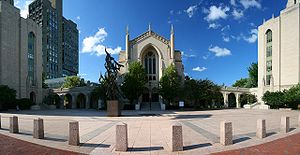
Marsh Plaza and its surrounding buildings were one of the first completed parts of the Charles River Campus.
Seeking to unify a geographically scattered school and enable it to participate in the development of the city, school president Lemuel Murlin arranged that the school buy the present campus along the Charles River. Between 1920 and 1928, the school bought the 15 acres (61,000 m) of land that had been reclaimed from the river by the Riverfront Improvement Association. Plans for a riverside quadrangle with a multistory administrative tower modeled on the "Old Boston Stump" in Boston, England were scaled back in the late 1920s when the State Metropolitan District Commission used eminent domain to seize riverfront land for Storrow Drive. Through a series of fundraising campaigns by Murlin, the school slowly filled in its new campus.
In 1951, Harold Case became the school's fifth president and under his direction the character of the campus changed dramatically, as he sought to transform the school into a national research university. The campus tripled in size to 45 acres (180,000 m), and added 68 new buildings before Case retired in 1967. The first large dorms, Claflin, Rich and Sleeper Halls in West Campus were built, and in 1965 construction began on 700 Commonwealth Avenue, later named Warren Towers, designed to house 1800 students. Between 1961 and 1966, the BU Law Tower, the George Sherman Union, and the Mugar Memorial Library were constructed in the Brutalist style, a departure from the school's traditional architecture. The College of Engineering and College of Communication were housed in a former stable building and auto-show room, respectively. In the late 1970s, when the Lahey Clinic vacated its building at 605 Commonwealth Avenue and moved to Burlington, Massachusetts, the building was purchased by BU to house the School of Education.
In the late 90s, concerns over lack of a "campusy" feel and the physical divide between the east and the western portion of campus triggered another wave of development. The John Hancock Student Village or StuVi was constructed with the intent of unifying the two campuses. This facility includes a new Fitness and Recreation Center (FitRec), a large multipurpose arena, and three new dormitories, one of which opened in 2000, the other two were finished by fall of 2009, including a 26-story new tallest on-campus building (left). The 19 and 26-story towers, known as StuV-II, house another 960 students, and have made possible the guarantee of on-campus housing to the 80% of its 16,000 undergrads who opt for it, without shunting overflow into nearby hotels as was the practice in past years.
As the expanding school grows skyward, hemmed in by a narrow footprint, BU declared intentions to procure air rights over the Mass Pike. In addition to freeing up land, it's hoped the move will unify the Charles River area with South Campus, as well as bring width to a long narrow campus.
校园
Boston campuses and facilities
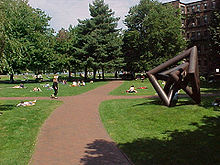
The "BU Beach", located behind Marsh Plaza and the College of Arts and Sciences building, is a popular warm weather gathering place between Charles River and Storrow Drive.
The University's main Charles River Campus follows Commonwealth Avenue and the Green Line, beginning near Kenmore Square and continuing for over a mile and a half to its end near the border of Boston's Allston neighborhood. The Boston University Bridge over the Charles River into Cambridge represents the dividing line between Main Campus, where most schools and classroom buildings are concentrated, and West Campus, home to several athletic facilities and playing fields, the large West Campus dorm, and the new John Hancock Student Village complex.
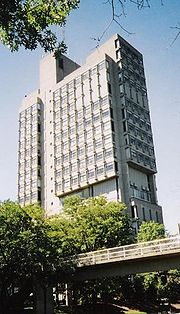
The School of Law Tower, made in Brutalist styling, is the tallest academic building on campus.
As a result of its continual expansion, the Charles River campus contains an array of architecturally diverse buildings. The College of Arts and Sciences, Marsh Chapel (site of the Marsh Chapel Experiment), and the School of Theology buildings are the university's most recognizable and were built in the late-1930s and 1940s in collegiate gothic style. A sizable amount of the campus is traditional Boston brownstone, especially at Bay State Road and South Campus where BU has acquired almost every townhouse those areas offer. The buildings are primarily dormitories but many also serve as various institutes as well as department offices. From the 1960s-1980s many contemporary buildings were constructed including the Mugar Library, BU Law School and Warren Towers, all of which were built in the brutalist style of architecture. The Metcalf Science Center for Science and Engineering, constructed in 1983, might more accurately be described as Structural Expressionism. Morse Auditorium, adjacent, stands in stark architectrual contrast, as it was constructed as a Jewish temple. The most recent additions to BU's campus are the Photonics Center, Life Science and Engineering Building, The Student Village (which includes the FitRec Center and Agganis Arena), and the School of Management. All these buildings were built in brick, a few with a substantial amount of brownstone.
Cultural life
Located at the junction of Fenway-Kenmore, Allston, and Brookline, the university has long enjoyed these neighborhood's cultural offerings. In the Fenway-Kenmore area are the Museum of Fine Arts, the Isabella Stewart Gardner Museum, and Landsdowne Street. Allston has been Boston's largest bohemian neighborhood since the 1960s. Nicknamed "Allston Rock City," the neighborhood is home to many artists and musicians, as well as a variety of cafés, and many of Boston's small music halls. Beyond the southern border of the campus in Brookline, Harvard Avenue offers independent and foreign films at Coolidge Corner Theatre, and readings by esteemed authors at the Brookline Booksmith. Other local destinations for campus intellectuals and culture lovers include Symphony Hall, the Beacon Book Annex, Jordan Hall, the main branch of the Boston Public Library in Copley Square, the art and commerce of Newbury Street, and, across the river, the museums, shops, and galleries in Harvard Square and elsewhere in Cambridge. The combined proximity of so many cultural institutions, colleges, public spaces, and performance outlets, with the University's own College of Fine Arts, College of Communication, University Professors Program, and other on-campus sources for cultural energy, has enabled BU to cultivate a thriving creative community. The George Sherman Student Union on Commonwealth Avenue hosts concerts and performers at "BU Central" and Metcalf Hall. BU is home to the Huntington Theatre Company at the BU Theatre as well as Boston Playwrights' Theatre, and hosts campus and non-campus performances in the Tsai Performance Center. Visiting artists' work are displayed in rotating exhibitions in the University's three galleries.
Student housing
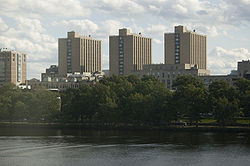
Rising over the Charles River, Warren Towers constitutes the second-largest non-military dorm in the country.
Main article: Boston University Housing System
Boston University's housing system is the nation's 10th largest among four year colleges. BU was originally a commuter school, but the university now guarantees the option of on-campus housing for four years for all undergraduate students. Currently, 76% of the undergraduate population lives on campus. Boston University requires that all students living in dormitories be enrolled in a year-long meal plan with several combinations of meals and dining points which can be used as cash in on-campus facilities.
Housing at BU is an unusually diverse melange, ranging from individual 19th-century brownstone town houses and apartment buildings acquired by the school to large-scale high-rises built in the 60s and 2000s. Because the university has so many students and is quickly running out of space to house them, the Hyatt Regency Cambridge across the river serves as a temporary dorm for some students during the fall semester.
The large dormitories include the 1800-student Warren Towers, the largest on campus, as well as West Campus and The Towers. The smaller dormitory and apartment style housing are mainly located in two parts of campus: Bay State Road and the South Campus residential area. Bay State Road is a tree-lined street that runs parallel to Commonwealth Avenue and is home to the majority of BUs town houses, often called "brownstones". South Campus is a student residential area south of Commonwealth Avenue and separated from the main campus by the Massachusetts Turnpike. Some of the larger buildings in that area have been converted into dormitories, while the rest of the South Campus buildings are apartments.
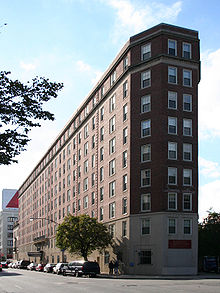
Built in 1925 as Myles Standish Hotel, BU acquired and converted the building to dorm space in 1949.
Boston University's newest residence and principal apartment-style housing area is officially called 10 Buick Street, a part of The John Hancock Student Village project. The apartments at 10 Buick Street are open to juniors and seniors only, and house more than 800 students in suite-style apartments.
Aside from these main residential areas, smaller residential dormitories are scattered along Commonwealth Avenue.
Boston University also provides specialty houses or specialty floors to students who have particular interests.
All large dormitories have 24/7 security and require all students to swipe and show their school identification before entering.
At least one dorm, Shelton Hall, is rumored to be haunted by the ghost of playwright Eugene O'Neill. O'Neill lived in what was originally room 401 (now 419) while the building was a residential hotel. He died in a hospital on November 27, 1953, and his ghost is rumored to haunt both the room and the floor. The fourth floor is now a specialty floor called the Writers' Corridor.
John Hancock Student Village
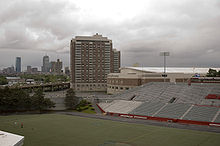
The rear of the John Hancock Student Village, with Nickerson Field in the foreground and Boston in the background.
Main article: John Hancock Student Village
The Student Village is a large new residential and recreational complex covering 10 acres (40,000 m) between Buick Street and Nickerson Field, ground formerly occupied by a National Guard Armory, which had been used by the University primarily (but not exclusively) as a storage facility before its demolition and the start of construction. The Student Village was designed with the intention of fostering community and bridging the divide between the eastern and western portions of campus. The dormitory of apartment suites at 10 Buick Street (often abbreviated to "StuVi" by students) opened to juniors and seniors in the fall of 2000. In 2002, John Hancock Insurance announced its sponsorship of the multi-million dollar project.
The Agganis Arena, named after Harry Agganis, was opened to concerts and hockey games in January 2005. The Agganis Arena is capable of housing 6,224 spectators for Terrier hockey games, replacing the smaller Walter Brown Arena. It can also be used for concerts and shows. In March 2005, the final element of phase II of the Student Village complex, the Fitness and Recreation (FitRec) Center, was opened, drawing large crowds from the student body. Construction on the rest of phase II, which included 19- and 26-story residential towers was finished in fall 2009.
Guest and visitor policies
Prior to September 2007, Boston University had a rather restrictive visitor policy, which limited the ability of students from different dormitories to visit each other at night. This changed when a new policy approved by Brown took effect.. The new policy allows for students living on campus to swipe into any on-campus dormitory between the hours of 7a.m. and 2a.m. using their ID cards Student residents can also sign in guests with photo identification at any time, day or night. Overnight visitors of the opposite sex are no longer required to seek a same-sex "co-host".. However during the week before final exams no guests are permitted in the halls overnight, and are expected to be out of the hall by 2 am.
Other facilities
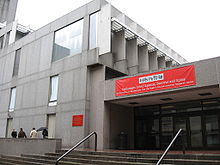
Mugar Memorial Library is BU's primary library
The Mugar Memorial Library is the central academic library for the Charles River Campus. It also houses the Howard Gotlieb Archival Research Center, formerly called the Twentieth Century Archive, where documents belonging to thousands of eminent figures in literature, journalism, diplomacy, the arts, and other fields are housed. Among them are Isaac Asimov's personal papers from 1965 onward, documents from distinguished alumnus Martin Luther King Jr, and the recent addition of Mary Louise Parker's personal papers.
The George Sherman Union (GSU) located next to Mugar Memorial Library provides students with an expansive food court featuring many popular fast-food chains, including Panda Express (which opened Fall 2006), Starbucks and Jamba Juice. The GSU also provides comfortable lounge areas in which to study. The basement of the George Sherman Union is home to the BU Central lounge, which hosts concerts and other activities and events. There is also a United States Post Office in the basement of the GSU.
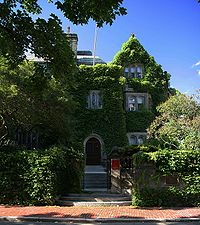
"The Castle" located on Bay State Road.
"The Castle" located on the West end of Bay State Road is one of the older buildings on campus, and one with an interesting, if not exactly accurate, history. According to lore, the castle was built by millionaire William Lindsay for his daughter Leslie Lindsey Mason as her wedding gift. However, she was killed when her ship, the RMS Lusitania, was torpedoed and sunk by German submarines on May 7, 1915. In fact the building was commissioned by William Lindsay for his own use in 1905, long before his daughter's honeymoon on the Lusitania. In 1939, the University acquired the property by agreement with the city to repay all back taxes owed; these funds were raised through donations from, among others, Dr. William Chenery, a University Trustee. It served as the residence of the University president until 1967, when President Christ-Janer found it too large for his needs as a residence and turned it to other uses. It is now a conference space. Underneath the Castle is the BU Pub, the only BU-operated drinking establishment on campus.
Parts of the 2008 film 21 were filmed at The Castle after undisclosed legal reasons prevented Robert Luketic from filming at MIT. Other areas around the Boston University campus, including Mugar Library and FitRec, also provided production locations for the film.
Boston University School of Education located at 605 Commonwealth Avenue is housed in the original location of the Lahey Clinic. It was the merger of two pre-existing buildings, which explains its half floors (3 1/2, 4 1/2, 5 1/2, etc.).
The recently opened Florence and Chafetz Hillel House on Bay State Road is the Hillel facility for the university. With four floors and a basement, the facility includes lounges, study rooms and a kosher dining hall, open during the academic year (including Passover) to students and walk-ins from the community. The first floor also includes the Granby St.Cafe as well as TV's and ping-pong, pool and foosball tables. The Hillel serves as a focal point for BU's large and active Jewish community. It hosts approximately 30 student groups, including social, cultural and religious groups and BU Students for Israel (BUSI), Holocaust Education and the Center for Jewish Learning and Experience. It hosts a plethora of programs and speakers as well as Friday and Saturday shabbat services and meals.
Weld House, the office of the president of Boston University, is the former home of Charles Goddard Weld, a member of the wealthy Weld family of Massachusetts. The adjoining Dunn House contains the Office of the Chancellor.
Barnes and Noble at Boston University is the university's bookstore, which is located on Kenmore Square. Consisting of five floors the bookstore holds all BU students' needs ranging from books to clothes to coffee. Materials for others schools such as the Boston Architecture Center are also sold through the store.
Accessing Boston University
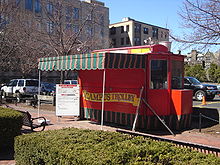
The Campus Trolley food truck on the corner of Granby Street and Commonwealth Avenue. The BU College of Arts and Sciences building is visible in the background
Most of the buildings of the main campus are located on or near Commonwealth Avenue. The Kenmore Square area of campus (including the Boston University Bookstore, Shelton Hall and Myles Standish Hall) may be accessed using the Kenmore Station Stop on the MBTA Green Line B, C and D trains. Most of the rest of the main campus may be accessed using the B trains of the Green Line between the Blandford Street and Pleasant Street stops. The 57 Bus runs along Commonwealth Avenue and into Allston and Brighton. The MBTA Commuter Rail Framingham/Worcester Line also stops near campus at Yawkey Station.
The Medical Campus is served by the 1 and CT1 Buses which runs along Massachusetts Avenue as well as the 47 and CT3 buses which connect the Boston University Medical Center with the Longwood Medical Area. The Silver Line Washington Street Branch runs the entire length of the campus, one block north of most parts of the campus; it connects Boston University Medical Center with Tufts/New England Medical Center and downtown Boston. The nearest underground T station is the Massachusetts Avenue station on the Orange Line, located 3 blocks north of the Medical Center.
The Boston University Shuttle (BUS) serves to connect the Main Campus, Boston University Theatre, and the Medical Campus.
Sustainability
Boston University's sustainability committee is working to "reduce energy consumption and decrease waste across the campus by concentrating on four crucial areas: recycling and waste management, energy efficiency, sustainable building development and operations, and communications, education, and outreach." One of the University's early steps toward creating a greener campus was implementing tray-free dining, which saved both water and cash. Moving forward, BU's newly-hired Director of Sustainability, Dennis Carlberg, will continue to focus the University more intensely on sustainability issues.
Other campuses
London 校园
Boston University's largest study abroad program is located in London, England. Boston University British Programmes offers a semester of study and work in London through their London Internship Program (LIP), as well as an adjunct non-internship program at Oxford University, St. Anne's College. Starting in Fall 2008, the programme at Oxford will only be a full academic year term, not just one semester as its been structured in the past. The LIP program combines a professional internship with coursework that examines a particular academic area in the context of Britain’s history, culture, and society and its role in modern Europe. Courses in each academic area are taught by selected British faculty exclusively to students enrolled in the Boston University program. Upon successful completion of a semester, students earn 16 Boston University credits. BU British Programmes are headquartered in South Kensington, London. The campus consists of the main building at 43 Harrington Gardens, as well as six flats that have been converted to house students. This program is open to Boston University students, as well as students at other American colleges, and enrolls between 650 to 850 students across Fall, Spring and Summer terms each year.
Dubai 校园
The University opened a new dental school in Dubai, UAE in 2007. The new dental program admitted its first group of students in July, 2008. In addition to BU’s dental facilities, the campus will eventually contain a wellness center, private clinics, and a major teaching hospital. "Dubai Healthcare City is a free medical zone within the Emirate of Dubai, has been developed as a world-class, academic medical community, which will be developed around the Harvard Medical School Dubai Center, Boston University Institute for Dental Research and Education, and a major university hospital", according to Kathi Ferland, director of admissions at GSDM.[2],[3]
Washington, DC 校园
In Washington, DC, BU has internship and journalism programs. Students live in the University's building on Connecticut Avenue in Woodley Park and take advantage of the city by interning at different locations. The journalism program, run by Linda Killian allows students to act as Washington, DC correspondents for newspapers and television stations across the Northeast and New England while interning at major news outlets in the city. BU Washington Internship Program, BU Washington Journalism Center
Los Angeles 校园
In Los Angeles, BU has an internship program for students to study and work in the heart of the film, television, advertising and public relations, and entertainment management and law industries. The program offers three tracks from which undergraduate and graduate students can choose: Advertising and Public Relations, Film and Television, and Entertainment Management. Graduated students have the opportunity to continue their education by enrolling in the Los Angeles Certificate Program, where students can choose either the Acting in Hollywood or the Writer in Hollywood track. Courses are taught by Boston University faculty and alumni who serve as mentors in and out of the classroom. Upon successful completion of a semester students will earn 16 Boston University credits. Students who successfully complete the Los Angeles Certificate Program will receive eight Boston University credits and a certificate from Boston University College of Fine Arts or College of Communication.
Admissions/demographics
Admission statistics for the Class of 2012 have reached a modern high with an increase of 4070 student applicants over a previous high of 33,894. The acceptance rate for the class of 2012 is 54.3%.
The incoming freshman class for 2007 was 68% white, 15% Asian, 7% international students, 7% Hispanic, and 2% black. Boston University also has the second highest number of Jews of any private school (after NYU) in the country with between 3,000 and 4,000, or roughly 15% identifying as Jewish.
The plurality of registrants were from Massachusetts (19%), followed by New York (16%), New Jersey (9%), California (8%), Connecticut (4%), Pennsylvania (4%), and Texas (2%).
学术
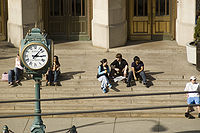
Students take a break on the steps of the College of Arts and Sciences.
Boston University offers bachelor's degrees, master's degrees, and doctoral degrees, and medical and dental degrees through its 18 schools and colleges. Each school and college at the university has a three letter abbreviation, which is commonly used in place of their full school or college name. For example, the College of Arts and Sciences is commonly referred to as CAS, the School of Management is SMG, the School of Education is SED, etc.
Colleges and schools
Colleges and schools at Boston University include:
-
- College of Fine Arts (CFA)
- College of Arts and Sciences (CAS)
- Graduate School of Arts and Sciences (GRS)
- College of Communication (COM)
- College of Engineering (ENG)
- College of General Studies (CGS)
- College of Health and Rehabilitation Sciences (Sargent College) (SAR)
- School of Education (SED)
- Division of Extended Education
- School of Hospitality Administration (SHA)
- School of Law (LAW)
- School of Management (SMG)
- Metropolitan College (MET)
- Boston University Brussels (BUB)
- Boston University Science and Engineering Program (SEP)
- School of Social Work (SSW)
- School of Theology (STH)
- University Professors Program (UNI) (will graduate its final class in 2011)
- School of Medicine (MED)
- Division of Graduate Medical Sciences (GMS)
- Goldman School of Dental Medicine (SDM)
- School of Public Health (SPH)
The College of Arts and Sciences (CAS) was formerly named the College of Liberal Arts (CLA). The College of Communication was formerly named the School of Public Communication (SPC). The School of Management (SMG) was formerly named the College of Business Administration (CBA). The College of General Studies (CGS) was formerly named the College of Basic Studies (CBS). The School of Nursing (SON) and the College of Practical Arts and Letters (PAL) are units that have been discontinued.
Rankings
|
|
University rankings (overall)
|
|
| ARWU World |
74 |
| ARWU North & Latin America |
44 |
| Times Higher Education |
56 |
| USNWR National University |
56 |
The Times Higher Education Supplement ranks Boston University 20th in the United States, and 56th in the world, in its 2009 list of the Top 200 Universities.
U.S. News & World Report ranks Boston University 56th among national universities for 2011. Boston University was also ranked 13th among public health graduate schools, 22nd among law schools, 22nd among social work schools, 34th among medical schools, and 56th among education schools. In the Arts and Sciences, BU was ranked 24th for economics, 31st among business schools, 35th among medical schools, 36th for physics, 42nd among engineering schools, 46th for English, 48th for history, 48th for math, 48th for computer science, 50th for psychology (33rd for clinical psychology), 55th for earth sciences, 57th for sociology, 58th for fine arts, 62nd in chemistry, and 89th for biology.
Shanghai Jiao Tong University created a now famous Academic Ranking of World Universities which ranks Boston University 44th in the United States for academic rigor, and 74th in the world, in its 2009 list of the Top 1000 Universities.
Newsweek (International Edition), in its list of the Top 100 Global Universities, ranked Boston University the 35th in the United States, and 65th in the world. Similarly, the Global University Ranking 2009 placed Boston among the 66 best universities worldwide.
The Biomedical Engineering Graduate and Undergraduate Programs are ranked 7th and 8th respectively in the nation and rising by U.S. News & World Report. The undergraduate program is also the sixth-largest ABET-accredited program in the nation.
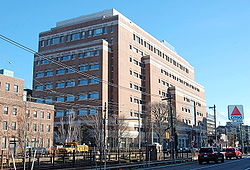
The Rafik B. Hariri Building houses the School of Management.
Additionally, most of the graduate programs in the Boston University College of Health and Rehabilitation Sciences (Sargent College) ranked within the top 15% in the country. The Occupational Therapy Program ranked 1st out of 152 programs; the Physical Therapy Program ranked 24th out of 199 programs; and the Speech-Language Pathology Program ranked 25th out of 244 programs.
U.S. News & World Report ranks Boston University School of Management 31st among national business programs for 2010.
Business Week ranks Boston University's MBA program 15th, and its undergraduate business program 37th.
The Economist ranks Boston University School of Management 21st among global MBA programs in 2009.
The Financial Times ranks Boston University's MBA program 29th among U.S. School and 57th in the world.
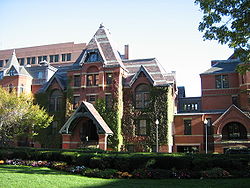
The Talbot Building located on the medical campus houses the School of Public Health, which is ranked 13th in the nation.
Shanghai Jiao Tong University's Academic Ranking of World Universities ranks Boston University 44th best overall university, and 42nd best undergraduate university in the United States (two schools ranked above BU are graduate schools only; UCSF and Rockefeller), as well as 74th best in the world, on its list of the Top 500 universities in the world.
The Center for Measuring University Performance. ranks Boston University among the top 50 research universities in the country.
The Wall Street Journal ranks Boston University's MBA program 41st nationally and the Information Technology department is ranked 10th in the world for academic excellence (September 2005).
The School of Management is ranked among the top 25 programs in the US by Entrepreneur magazine (April 2005).
BU is one of 96 American universities receiving the highest research classification ("RU/VH") by the Carnegie Foundation.
The Sustainable Endowments Institute awarded Boston University a "B-" grade for its efforts in sustainability on the College Sustainability Report Card 2009. The University's mark on the Report Card has improved steadily since 2007. In that year it earned a "D", and in 2008 it earned a "C."
Cost
The 2007–2008 school year tuition totaled $34,930, with total costs (including room and board) averaging $45,880. The total estimated cost of attendance for the 2008–2009 school year will be $47,958 for on-campus students.
The standard on-campus housing component of this cost is approximately $8,000 a year while more premium choices in the newer Student Village residence halls run nearly $13,000 a year. By comparison, the average rent for a two-bedroom apartment in the Allston-Brighton area is $1300, or $7800 per person per year.
Grade deflation
The independently-run student newspaper at Boston University, The Daily Free Press, as well as the The New York Times, have published articles exploring the existence of grade deflation. The Times discovered that administrators have suggested to faculty members deflated ideal grade distributions. Though an article in the staff's BU Today asserted that "the GPAs of BU undergrads and the percentage of As and Bs have both risen over the last two decades," the New York Times has found BU grades rising more slowly with respect to many other schools.
Currently, the average GPA of a BU undergraduate is 3.04, with about 81 percent of all grades earned in either the A or B range." The article went on to note that although the university attempted to curb grade inflation and inconsistency in the late 1990s both the percentage of "A's" and GPAs have been rising since. They attributed the grade inflation not to teachers' grading policies, but to the increasing quality of each incoming class which leads to more top grades.
Special academic programs
Core Curriculum
Offered in the College of Arts and Sciences, the Core Curriculum offers an intensive great books program for any incoming freshmen who choose to participate. Occupying two classes a semester during freshman and sophomore years, the program has four humanities sections which start with Gilgamesh and work their way through Plato, Aristotle, Aeschylus, Machiavelli, Shakespeare, Milton, Dante, Bach and many more. The Social Sciences part of the program includes Hobbes, John Locke, Rousseau, Adam Smith, Marx, and continues through contemporary works. Lastly, the science aspect of the program deals with major ideas such as big bang theory, evolution, quantum mechanics and more. Ultimately, the program seeks to combine science, math, humanities, art, and the social sciences into a cohesive program to give students insight into their world and help them become more refined writers and scholars.
University Professors Program
The University Professors Program (UNI) is an interdisciplinary program that allows students to pursue a broad range of academic interests. With a student to faculty ratio of 4:1, UNI offers students a broad education in a more personalized atmosphere. Students take a common, intimate, "Core" program consisting of liberal arts courses taught by University Professors in small seminar settings. They then work closely with an advisor to craft a course of study which will lead them to an interdisciplinary degree, culminating in a senior thesis. Based upon the report of an academic review committee, a new University-wide honors program will be developed and the UNI program will be gradually phased out. Students currently enrolled will continue in the program.
Student life
Student publications
Despite a Student Activities policy which prohibits student-run publications from receiving University funding for printing costs, student journals continue to thrive at Boston University as department-sponsored publications, edited by students under the supervision of faculty and staff advisors. The coordinator for undergraduate publications, responsible for acquainting new editors with University guidelines and directing publications staff to campus production and financial resources, has been Zachary Bos of the Core Curriculum since 2006.
Although officially and entirely independent from the University, The Daily Free Press (often referred to as The Freep), is the campus student newspaper, and the fourth largest daily newspaper in Boston. Since 1970, it has provided students with campus news, city and state news, sports coverage, editorials, arts and entertainment, and special feature stories. The Daily Free Press is published every regular instruction day of the University year and is available at BU dorms, classroom buildings and commercial locations frequented by students.
Synapse is the Boston University Undergraduate Science Magazine and is published online every semester. The "Science" focus is on many disciplines ranging from life sciences to physical sciences, engineering to mathematics, and finance to economics. The magazine is peer and faculty reviewed, and is advertised with routine, campus-wide distribution of pamphlets highlighting featured articles. Synapse was first published in the spring of 2009 and continues to publish articles each semester.
The Brownstone Journal is the longest-running campus publication, having been publishing undergraduate research, scholarly articles and essays, and literary work in translation, since 1982. The Brownstone is currently sponsored by the Undergraduate Research Opportunities Program, but was originally a departmental publication of the University Professors Program. The staff operates from their offices in the former yearbook space in the basement of 10 Lenox Street, beneath the editorial offices of Bostonia.
The literary arts magazine Clarion has been printed since 1998. The first issue, titled "?", was published by the group Students for Literary Awareness with the sponsorship of the Department of English; subsequent issues have been issued by the BU Literary Society. Burn Magazine is a younger literary magazine, published biannually.
In 2006, the first issue of Pusteblume journal of translation was published by a group of former and current students of a co-curricular poetry seminar run by Professor George Kalogeris of the Core Curriculum. The journal, jointly sponsored by the Department of Romance Languages, the Department of Modern Languages and Comparative Literatures, and the Core Curriculum, publishes literature in translation and articles concerning translation.
The Journal of the Core Curriculum has been published continuously since 1992 by the College of Arts and Sciences Core Curriculum. Produced by a student editorial staff with the guidance of a faculty advisor, the very interdisciplinary Core Journal publishes academic prose, literary imitations, fictitious encounters between figures from the 'great works', original poetry and creative writing, essays, artwork, translations, and even—in Vol. XVI, Spring 2007—original musical compositions. The Back Bay Review is a student-run journal of critical writing.
Arché is an annual journal of undergraduate work in philosophy, whose first issue was released in the summer of 2007. It is sponsored by the Department of Philosophy and published by the Undergraduate Philosophy Association.
The International Relations Review began in 2009 as a subsidiary publication of The Boston University International Affairs Association. Entirely student-run, The IR Review is an independent scholarly journal publishing articles from all areas in international affairs. The goal of The IRR is to unite the many talents and experiences within BU's vast department of international relations.
Even more independent, The Student Underground, focuses on alternative political and cultural activity. Since 1997, issues have been published roughly monthly by a "not-for-profit collective" composed mostly of BU students. In 2007, the paper began operating under the name The Boston Underground; the original editorial focus on campus issues has over the years weakened as the founding editors graduated from BU or left Boston altogether.
The Sam Adams Review was a short-lived monthly student newspaper "providing news for the American Spirit," geared toward a conservative readership. Its staff was not officially recognized as a registed student activity group but, like the Underground, was entirely student-run.
Boink was launched in February 2005 by a group of undergrads led by Alecia Oleyourryk, who was then a senior at the College of Communications. The magazine features BU students posing nude, as well as articles on sexuality. At the time of its first issue, the Dean of Students issued a statement explaining that "the University does not endorse, nor welcome, the prospective publication Boink." The magazine was then, and remains, unaffiliated with the University.
In September 2005, the student paper The Source began to appear weekly, and was characterized by a predominance of arts and entertainment coverage. No new issues were printed after November 2006, and it appears the publisher Greenline Media is now defunct.
The "BU Quad" is an independent, student-run online magazine started in fall of 2009. The magazine features articles and columns on topics including campus news, television, food, politics, and music.
Community Service Center
The Boston University Community Service Center (CSC) is almost entirely student-run. Each semester, the CSC runs 13 volunteer programs related to issues of local, national, or global concern, including hunger, children, elders, disabilities, homelessness and affordable housing, human rights, AIDS awareness, gender issues, and the environment.
The CSC also runs two immensely popular one-week programs. During the First Year Student Outreach Project (FYSOP), upperclassmen lead groups of new freshmen in volunteer activities throughout Boston before the start of first semester. For Alternative Spring Break (ASB), hundreds of students travel by 14-passenger van to locations throughout the country to do service projects in a variety of areas of need. This program has gotten so popular that students camp out, starting the day before signups, to get spots on trips.
The CSC boast the most student involvement of any organization on campus.
Graduate workshops
Willing Suspension Productions provides graduate English students the opportunity to present rare Early modern drama before a Boston audience. The program was founded in 1993 and produces one play per year.
ROTC
ROTC at BU traces its origins back to August 16, 1919 when the U.S. War Department stood up the Students’ Army Training Corps at Boston University, the predecessor to the current Army ROTC program. Today, BU is one of the relatively few colleges and universities in the country to host ROTC units from all four Armed Services – Army, Navy, Marine Corps and Air Force. Students wishing to commission into the Marine Corps study as Navy Midshipmen.
Other clubs and activities
- The Boston University Dear Abbeys is an acclaimed All-Male student a cappella group. In 2005, they won the International Championship of Collegiate A Cappella, a prestigious nation-wide tournament for collegiate a cappella groups.
- Boston University Stage Troupe is the University's oldest and largest performing arts group. Open to undergrads not majoring in theatre, the group performs many shows a year, and also hosts special events, some of which are coordinated with the Dean of Students.
- The Boston University Debate Society regularly competes on the American Parliamentary Debate Association debate circuit.
- The Boston University International Affairs Association (BUIAA) is the evolution of the Boston University Model United Nations Association (BUMUNA), which was founded in 1973. This club also hosts two conferences annually, one for high school students and one on the collegiate level. BosMUN, BUMUNA's high school conference, hosts over 1,000 students annually from all across the globe. Last year, schools came from China, Guatemala, and Canada. BarMUN (Boston Area Model United Nations Conference) is BUMUNA's college level conference. BarMUN stands apart from other college conference in that the conference is a full scale simulation, ranging from 4-8 committee joint crises.
- The Hug Don't Hate grassroots peace-building campaign was founded in 2006 at Boston University with the mission of creating lasting peace through happiness, understanding and respect. All of Hug Don't Hate's activities are focused on helping individuals find common ground. The activities are divided into 4 branches: 'Free Hug Fridays', 'Urban Smiles', 'Connective Kindness' and 'BUNITED'. Hug Don't Hate is also currently expanding to different locations.
- The Greek community on BU's campus consists of nine sororities (nine Panhellenic chapters), ten fraternities (seven Inter-Fraternity Council chapters) and recently created Multicultural Greek Council (four fraterneties and one sorority). The student population that is Greek is currently 8% and growing. In 2008, over 560 women went through formal sorority recruitment which occurs the first weekend of 2nd semester.
- The Boston University India Club is the University's largest student-run organization. Open to students of all ethnic backgrounds, the club sponsors cultural shows, performances and activities that showcase South Asian culture. BUIC also hosts and organizes the annual GarbaFest Competition, a garba raas competition.
- Lambda Chi Alpha (ΛΧΑ), a member of the North-American Interfraternity Conference (NIC) and one of the largest men's general fraternities in North America, was founded by Warren A. Cole, while he was a student at Boston University, on November 2, 1909.
- Delta Delta Delta (ΔΔΔ) was founded at Boston University on Thanksgiving Eve, 1888. Sarah Ida Shaw, later known as Ida Shaw Martin, founded Tri Delta without the assistance of a men's fraternity, a unique accomplishment for her time.
- The College of Arts and Sciences (CAS) Dean's Hosts are a premier student volunteer organization where members serve as liaisons between CAS students and faculty members. Most notably, CAS Dean's Hosts along with CAS Student Government throw the Top of the Hub formal in downtown Boston annually.
- The "Boston University Soccer Club" is an athletic-based club that allows members of the BU community to participate in a variety of soccer related events ranging from pick-up futsal games at the Fitness and Recreation Center, to philanthropic fundraising matches such as the annual "Lose the Shoes" charity tournament, from which all the proceeds go to the GrassrootSoccer campaign. http://www.grassrootsoccer.org/ The motto of the club is: "Unifying diversity through the love of the world's beautiful game."
- CAS Student Government is the College of Arts and Sciences's student government group. Each year they work with the administration of the College of Arts and Sciences to deal with multiple student affairs issues within CAS. They also program many events for the students of CAS including: Celtics Night, Coffee at Finals, Ice Skating at Frog Pond, Senior Reception, and many more.
体育运动
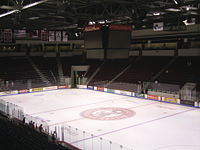
Inside Agganis Arena after a hockey game.
Main article: Boston University Terriers
See also: Boston University Terriers men's ice hockey
Boston University's NCAA Division I Terriers compete in basketball, cross country, golf, ice hockey, rowing, soccer, swimming, tennis, track, and wrestling, while the Lady Terriers compete in basketball, dance, cross country, field hockey, golf, ice hockey, lacrosse, rowing, soccer, softball, swimming, tennis, and track. Boston University athletics teams compete in the America East, Hockey East, and Colonial Athletic Association conferences, and their mascot is Rhett the Boston Terrier.
The Boston University men's hockey team is the most successful on campus, and is a storied college hockey franchise, with five NCAA championships - including the 2009 NCAA title, which was a classic last-minute comeback victory. The team is coached by hall-of-famer Jack Parker, and is a major supplier of talent to the NHL, as well as to the 1980 U.S.A. Gold Medal-winning men's hockey team. Boston University's hockey team has won 29 Beanpot titles, over half of all 57 Beanpot championships thus far. The annual tournament includes Harvard University, Boston College, and Northeastern University. Boston University also won the Sun Life Frozen Fenway contest in 2010 against Boston College by a score of 3-2. It was an outdoor Hockey East college game played at Fenway Park a week after the NHL Winter Classic.
BU has also won two national championships in women's rowing, in 1991 and 1992.
Boston University recently constructed the new Agganis Arena, which opened on January 3, 2005 with a men's hockey game between the Terriers and the University of Minnesota Golden Gophers. The Agganis Arena is also used occasionally to host other non-sporting related events.
Boston University disbanded its football team in 1997. The university used the nearly $3 million from its football program to build the multimillion-dollar John Hancock Student Village and athletic complex. Among the biggest benefactors of the decision was BU women, who saw the funding for their teams increased. "By implementing the total plan, we can achieve a much more balanced set of sports programs for both men and women, which is consistent with the philosophy underlying Title IX," said former BU athletic director Gary Strickler.
Club sports
Boston University students also compete in athletics at the club level. Thirty five club sports are recognized by the university, including: Synchronized Skating, Baseball; Inline Hockey; Men's Volleyball; Women's Volleyball; Men's Lacrosse; ; Snowboard; Ultimate Frisbee; Kung Fu; Fencing; Rugby Football; Synchronized Swimming; Cheerleading; Table Tennis; Women's Water Polo; Men's Water Polo; Women's Rugby; Alpine Ski Racing; Snowboarding; Cycling; Badminton; Ballroom Dance; Figure Skating; Golf; Gymnastics; Jiu Jitsu; Kendo; Shotokan Karate; Sailing; Triathlon; Dance Theater Group; Squash, Equestrian, Inline Hockey, and Men's Club Football
The BU Table Tennis team has won the divisional championships a number of times this decade, most recently in 2006 (Men's) and 2007 (Women's). Both Men's and Women's Intervarsity Table Tennis Teams have attended the National Collegiate Table Tennis Tournaments and ranked as high as the top 10 nationwide.
The BU Dinghy Sailors are the most recent BU team to win a national championship for the school at the varsity level, having won the ICSA Collegiate Nationals in 1999.
The BU Figure Skating Team recently won the 2009 Intercollegiate National Figure Skating Championships held in Colorado Springs, CO.
Fight song: "Go B.U."
Go BU, Go BU!
Sing her praises loud and true!
We'll fight for our alma mater,
On to sure victory!!
Fight! Fight! Fight!
Go BU, Go BU!
Down the field to score anew!
Our hearts are with you as you meet the foe.
We hail you, Ole BU!
Due to the lack of a football team since 1997, students use the word "ice" instead of "field" in the seventh line at hockey games, and "court" at basketball games.
Additionally, in the "unofficial" version of the song, often sung by students, the words "Fight! Fight! Fight!" are replaced with "BC sucks!", a nod to the rivalry between the two schools.
[edit] 知名校友与教职
Main article: List of Boston University people
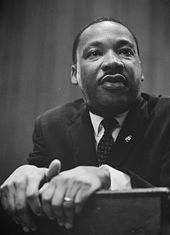
Martin Luther King, Jr. earned a Ph.D. from BU in 1955.
There are 285,000 Boston University alumni, representing almost every country in the world. Boston University graduates have won numerous prestigious prizes, fellowships, and awards, including Nobel and Pulitzer prizes, as well as Rhodes, Fulbright, Marshall, Truman, and St. Andrew scholarships, among others. Martin Luther King, Jr. is one of BU's most notable alumni. Other well-known alumni include actors Julianne Moore and Geena Davis, former Defense Secretary William Cohen and current Commerce Secretary Gary Locke, radio personality Howard Stern, sports writer Bill Simmons, television personality Bill O'Reilly, and Tipper Gore, wife of Al Gore.
Current and former faculty of BU include Elie Wiesel, Howard Zinn, Isaac Asimov, Derek Walcott, Robert Pinsky, Bob Zelnick, Abhishek Bacchan, and Andrew Bacevich.
[edit] 更多
- Boston University Police Department
- Einstein Papers Project
参考文献
- ^ "The origin of BU's motto: Learning, Virtue, Piety". BU Today. 2005-10-20. http://www.bu.edu/today/campus-life/2007/09/16/origin-bus-motto-learning-virtue-piety. Retrieved 2009-11-22.
- ^ About BU page, with founding date http://www.bu.edu/info/about/
- ^ "Separated brethren: a review of Protestant, Anglican, Eastern Orthodox & other religions in the United States". Our Sunday Visitor. 2002. http://books.google.com/books?id=sw9ILcqw2hsC&pg=PA162&lpg=PA162&dq=salvation+of+separated+brethren&source=bl&ots=ydrVxGCZ6w&sig=L_-DZRvpoMtZSDkrT6HNQcmd4aU&hl=en&ei=xfSvS52yE4faNZX_zJkF&sa=X&oi=book_result&ct=result&resnum=3&ved=0CA0Q6AEwAjgK#v=onepage&q=methodist&f=false. "Among Protestant denominations, Methodists take first place in hospitals and colleges. Some of their one hundred colleges and universities have all but severed ties with the denominations, but others remain definitely Methodist: Syracuse, Boston, Emory, Duke, Drew, Denver, and Southern Methodist. The church operates three hundred sixty schools and institutions overseas. Methodists established Goodwill Industries in 1907 to help handicapped persons help themselves by repairing and selling old furniture and clothes. The United Methodist Church runs seventy-two hospitals in the United States."
- ^ "Boston University". International Association of Methodist-related Schools, Colleges, and Universities (IAMSCU). http://public.gbhem.org/iamscu/search_results.asp?act=search_gen&search_txt=Boston+University&type=schools&submit=GO. Retrieved 2007-06-30. "
BOSTON UNIVERSITY
Dr. Robert A. Brown, President
One Sherborn Street
Boston, MA 02215
UNITED STATES OF AMERICA
Main Phone: (617) 353-2000
Fax: (617) 353-3278
Primary Email: rabrown@bu.edu
Web: http://www.sthweb.bu.edu
Denomination: United Methodist
Year established: 1839
Student enrollment: 31,697
Baccalaureate
Post-baccalaureate"
- ^ "United Methodist schools score high in rankings". The United Methodist Church. http://archives.umc.org/interior.asp?ptid=2&mid=5585. Retrieved 2007-06-30. "Other United Methodist schools on the top national list are Syracuse (N.Y.) University (tied for 52nd); Boston University (tied for 56th); Southern Methodist University, Dallas (tied for 71st); and American University, Washington (tied for 86th)."
- ^ "Financials, Annual Report 2009". Boston University. December 17, 2009. http://www.bu.edu/ar/2009/financial/. Retrieved December 17, 2009.
- ^ "Boston University Information Center - Quick Facts". http://www.bu.edu/dbin/infocenter/content/index.php?pageid=873. Retrieved 2009-11-22.
- ^ "Boston University Brand Identity Standards - Master Logo Colors - Boston University Red". http://web.bu.edu/brand/logo/colors/. Retrieved 2009-11-22.
- ^ "Boston University". Association of Independent Colleges and Universities in Massachusetts. http://www.masscolleges.org/index.php?option=com_content&task=view&id=208&Itemid=206. Retrieved 2007-06-30.
- ^ "Boston University Undergraduate Bulletin 2009/2010 - The University". One Silber Way, Boston, MA 02215: Trustees of Boston University. 2009-10-16. http://www.bu.edu/bulletins/und/item02.html. Retrieved 2009-11-22. "Boston University, the fourth-largest independent university in the United States [...] With more than 4,000 faculty members and more than 32,000 students..."
- ^ <[http://www.bostonredevelopmentauthority.org/PDF/ResearchPublications//Boston%20Economy%202008.pdf "The Boston Economy 2008 Holding Strong"]. Boston Redevelopment Authority – Research Division. September 2008. p. 16. http://www.bostonredevelopmentauthority.org/PDF/ResearchPublications//Boston%20Economy%202008.pdf. Retrieved 2009-11-22. "Largest Private Employers in Boston, April, 2006 (With 1,000+ employees, listed alphabetically)"
- ^ Carnegie Foundation
- ^ http://www.bu.edu/research/about/stats/
- ^ http://www.boston-consortium.org/about/what_is_tbc.asp
- ^ Boston University | Visitor Center | About the University |History, retrieved May 6, 2006
- ^ "Between World Wars". Boston University. http://www.bu.edu/visit/about/history/betweenwars.html. Retrieved 2008-04-28.
- ^ Alex Taylor. "Activism, dorm construction pervade campus in 1950s-60s". The Daily Free Press. http://media.www.dailyfreepress.com/media/storage/paper87/news/2006/10/17/News/Activism.Dorm.Construction.Pervade.Campus.In.1950s60s-2371894.shtml. Retrieved 2008-04-27.
- ^ "Lahey History". The Lahey Clinic. http://www.lahey.org/About/LaheyHistory.asp. Retrieved 2009-12-28.
- ^ Boston University Office of the 校长
- ^ http://www.boston.com/news/local/massachusetts/articles/2009/09/02/bu_dorm_offers_a_study_in_luxury/?page=1
- ^ BU says campus future is up in the air - News
- ^ Boston Globe, "Rock City revival", August 27, 2004
- ^ BU Bridge Vol II No. 24, 19 Feb 1998 "BU Yesterday: Third time's the dorm"
- ^ Boston University | Office of Housing | Dining Plans and Convenience Points|Dining Plans, retrieved May 6, 2006
- ^ "President Approves New Guest Policy" ~ BU Today May 7, 2007
- ^ "New Guest Policy Means More Power, More Responsibility" ~ BU Today March 2, 2007
- ^ BU Guest Policy
- ^ 403 Forbidden accessed 8 May 2006
- ^ Salzman, Nancy Lurie. Buildings and builders : a history of Boston University. Boston : Boston University Press, 1985. (ISBN 0-87270-056-9)
- ^ BU Pub offers college experience
- ^ Dailey Free Press, 27 Feb 2007 Actor, producer Spacey brings filming to BU Castle
- ^ Hillel House web site
- ^ Harvard Alumni Magazine, "The Welds of Harvard Yard" by associate editor Craig A. Lambert
- ^ ""A Greener BU: Look, Mom, No Trays!"". BU Today. http://www.bu.edu/today/node/7361/. Retrieved 2009-06-05.
- ^ BU Study Abroad
- ^ BU British Programmes
- ^ "Boston University - Best Colleges - Education - US News and World Report". http://colleges.usnews.rankingsandreviews.com/best-colleges/boston-ma/boston-university-2130. Retrieved 2009-11-16.
- ^ Reform Judaism Magazine
- ^ Hillel.org
- ^ Hillel.org
- ^ "Freshman Profile". Boston University. http://www.bu.edu/dbin/infocenter/content/index.php?pageid=909&topicid=12. Retrieved 2008-08-05.
- ^ Shanghai Jiao Tong University (2009). "Academic Ranking of World Universities". Institute of Higher Education, Shanghai Jiao Tong University. http://www.arwu.org/ARWU2009.jsp. Retrieved 2009-12-23.
- ^ Shanghai Jiao Tong University (2009). "Ranking of North & Latin American Universities". Institute of Higher Education, Shanghai Jiao Tong University. http://www.arwu.org/Americas2009.jsp. Retrieved 2009-12-23.
- ^ The Times (2009). "World University Rankings". The Times Higher Educational Supplement. http://www.topuniversities.com/university-rankings/world-university-rankings/2009/results. Retrieved 2010-02-09.
- ^ "National Universities Rankings". America's Best Colleges 2009. U.S. News & World Report. 2009. http://colleges.usnews.rankingsandreviews.com/college/national-search. Retrieved 2009-05-18.
- ^ Times Higher Education Supplement
- ^ Rankingsandreviews.com
- ^ http://grad-schools.usnews.rankingsandreviews.com/best-graduate-schools
- ^ http://grad-schools.usnews.rankingsandreviews.com
- ^ [1]
- ^ MSN, retrieved September 18, 2006
- ^ http://www.globaluniversitiesranking.org/images/banners/top-100(eng).pdf
- ^ "Sargent College Facts & Statistics". http://www.bu.edu/sargent/admissions/facts/.
- ^ http://grad-schools.usnews.rankingsandreviews.com
- ^ "2010 Undergrad B-School Rankings". http://www.businessweek.com/bschools/rankings/. Retrieved 2010-04-17.
- ^ http://www.economist.com/business-finance/business-education/whichmba/
- ^ "FT.com / Business Education". http://rankings.ft.com/rankings/mba/rankings.html?queryParam=&selectorField1=Career+progress+rank&selectorOption1=All+results&selectorField2=&selectorOption2=&selectorField3=&selectorOption3=&lastSort=&sortBy=Career+progress+rank&x=14&y=9. Retrieved 2006-06-19.
- ^ Top 500 World Universities (1-100), retrieved August 15, 2006
- ^ "The Top American Research Universities: 2006 Annual Report". 2006. http://mup.asu.edu/research2006.pdf. Retrieved 2007-04-15.
- ^ The College Sustainability Report Card
- ^ The College Sustainability Report Card
- ^ The College Sustainability Report Card
- ^ Art Jahnke. "The Higher Cost of Higher Ed". http://www.bu.edu/today/2008/03/11/higher-cost-higher-ed. Retrieved 2008-04-29.
- ^ http://www.allstonbrightoncdc.org/pdfs/AB%20Housing%20Study.pdf page 9, rent as of 2006
- ^ Freedman, Samuel G. (2006-06-07). "Can Tough Grades Be Fair Grades?". The New York Times: p. B8. http://www.nytimes.com/2006/06/07/education/07education.html. Retrieved 2006-06-07.
- ^ Berdik, Chris (2006-09-14). "Grade Deflation or Not?". BU Today. http://www.bu.edu/phpbin/news-cms/news/?dept=4&id=40427&template=7. Retrieved 2006-10-06.
- ^ "Boston University - UNI Program". http://www.bu.edu/uni. Retrieved 2007-09-24.
- ^ BU Synapse 网址
- ^ http://buquad.com/
- ^ Boston University - Division of Military Education, retrieved May 6, 2006.
- ^ web site for Boston Model UN VIII
- ^ web site
- ^ Student Activities Office Web site about Fraternity/Sorority activities
- ^ National Collegiate Athletic Association
- ^ http://www.boston.com/sports/colleges/mens_hockey/articles/2010/01/09/great_outdoors/
- ^ Rowing Championships, on wikipedia
- ^ Hanson, Gayle M.B. & Berg, Stacie Zoe. Long on losses, short on funds, BU football lets clock run out. Insight on the News (Dec 15, 1997).
- ^ The National Champions You Might Not Know, Bostonia Magazine, Summer 2009
- ^ http://www.bu.edu/alumni/buaa/
- ^ http://www2.bu.edu/bufellow/pastwinners/past.htm
扩展阅读
- Kilgore, Kathleen (1991). Transformations: A History of Boston University. ISBN 0-87270-070-4.
- Saltzman, Nancy (1985). Buildings and Builders: a History of Boston University. Boston: Boston University Press. ISBN 0-87270-056-9.
- Wertheimer, Linda K. BU to launch $1.8b plan to expand, upgrade faculty. Boston Globe, October 18, 2007.
- Boston University strategic plan. Choosing to Be Great: A vision of Boston University—past, present, and future, November 19, 2007.
External links
 |
Wikimedia Commons has media related to: Boston University |
|
Boston University |
|
| Schools |
College of Arts and Sciences • College of Communication • College of Engineering • College of Fine Arts • College of Health and Rehabilitation Sciences • Goldman School of Dental Medicine • School of Education • School of Law • School of Management • School of Medicine • School of Public Health • School of Social Work • School of Theology • University Professors Program
|
|
| Research |
Center for Millennial Studies • Judson B. Coit Observatory • Metcalf Science Center • Photonics Center
|
|
| Athletics |
Agganis Arena • Beanpot • Boston University Terriers • Case Gym • FitRec • Green Line Rivalry • Nickerson Field • Rhett the Boston Terrier • Walter Brown Arena
|
|
| Housing |
Boston University Housing System • 10 Buick Street • 575 Commonwealth Avenue • Myles Standish Hall • Shelton Hall • The Towers • Warren Towers
|
|
| Media |
AGNI (magazine) • Arion • Burn • BUTV10 • Clarion • The Daily Free Press • The International Relations Review • News from the Republic of Letters • WTBU
|
|
| Miscellaneous |
Boston Medical Center • BU Medical Campus • BU Police • BU Castle • George Sherman Union • Morse Auditorium • Mugar Memorial Library • WBUR
|
|



